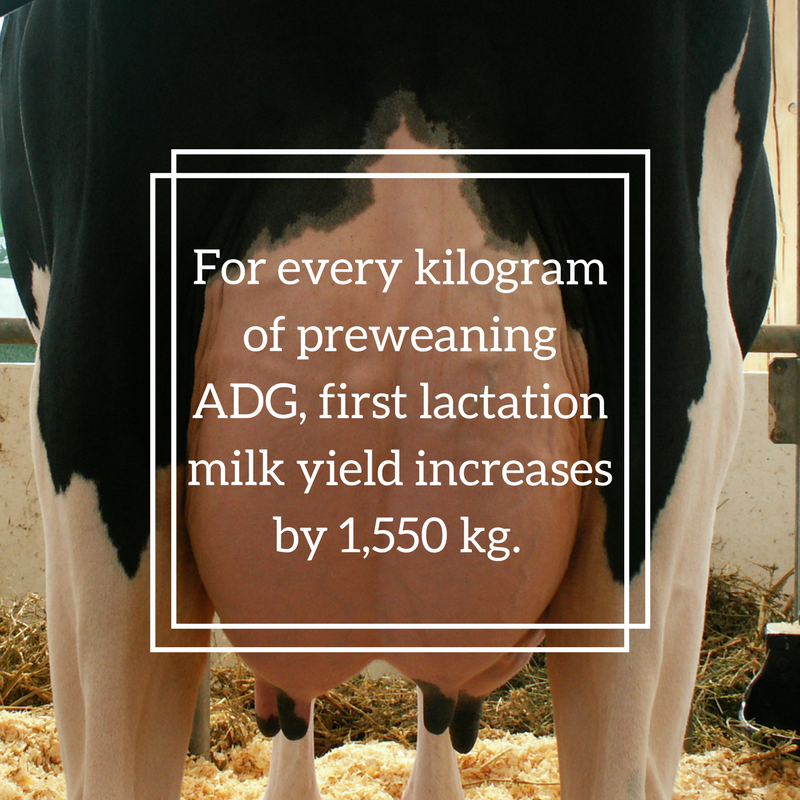Healthy Calf Conference
Follow to stay up-to-date on all Healthy Calf Conference updates. Speaker announcements, sponsorship information, registration announcements, and more.

In Canada, calves are generally fed about ten percent of their body weight in milk or milk replacer per day during the milk feeding period (up to an average of six to eight weeks). For a Holstein calf, this is about four to six litres. In a 2010 survey of Quebec dairy farms, researchers found that the average milk feeding program was a total of four litres of milk given in two meals per day for the first week of life followed by five and a half litres per day given in two meals per day until weaning.
Calves on an automatic feeder with unlimited milk allowance and no competition will have several small meals throughout the day. This adds up to an average of ten kilograms of milk or milk replacer per day (approximately ten to twelve litres) over ten feedings. For Holsteins, this is about twenty percent of their bodyweight, more than double what the average Canadian calf receives.
However, there is a lot of variation from calf to calf in amount of milk consumed and number of meals per day. In one study, individual calves drank between five and sixteen kilograms per day in three to twenty two meals. These individual differences can make it hard to determine the best milk feeding schedule for the whole calf herd.

There are many benefits to allowing calves to drink increased amounts of milk, which may outweigh the increased cost of milk replacer. Advantages include increased growth and higher average daily gain, better health, improved feed efficiency, less abnormal behaviours (such as cross sucking), accelerated age at first calving, and increased milk production during the first lactation.
Many producers worry that increasing the milk intake will decrease starter intake. While this is true, calves fed a high amount of milk replacer quickly begin to eat solid feed during and after weaning. When using gradual weaning (reducing milk allowance over a period of several days), calves fed a high amount of milk replacer experience no lag in growth, and continue to outgrow calves that were fed less milk (even though these calves ate more starter before weaning). Very young calves are not very efficient at to turning calf starter into growth. Most calf growth comes from the nutrients in milk or milk replacer.
It is important to note that there is no evidence that feeding large amounts of milk to calves leads to diarrhea. While calves drinking larger milk allowances may have looser manure, this is normal, and expected, due to the increased amount of liquid in the diet.
Increasing the meal frequency of calves from two times a day to three times a day leads to a higher (less acidic) and more stable abomasal pH, reducing the risk of abomasal acidosis. A higher abomasal pH may also reduce the risk of abomasal ulcers, a widespread but frequently undiagnosed problem in calves (one study of veal cattle found 40-66% of calves were affected). Further, it is thought that large milk meals may stretch the abomasum, potentially causing or worsening damage.
Abomasal ulcers may be painful or uncomfortable and can progress to haemorrhage (bleeding), perforation (hole in the abomasum), and peritonitis (infection in the body cavity). These consequences will reduce health, welfare, and productivity and can lead to death. As abomasal damage is typically subclinical (meaning the calf will show no outward symptoms), preventing, rather than treating, damage is the best approach.
For this reason, adding extra milk to a feeding program as an additional meal may be more ideal than increasing the size of the existing meals. However, as the link between feeding large amounts of milk and abomsal damage is not clear, the benefits of allowing calves to drink additional milk, even if it is at two feedings, may outweigh the risk of abomasal damage.
In one study, calves fed milk four times a day had an increased starter intake in the two weeks after weaning, when compared to calves fed the same amount of milk in two meals per day. Calves allowed to have more frequent meals also have improved feed efficiency, reduced abomasal damage, and reduced amounts of milk spilling into the rumen (which can lead to ruminal acidosis).

There are welfare, health, and productivity benefits to trying to more closely imitate the calf’s natural feeding behaviour by increasing the amount of milk fed as well as the frequency of meals. Automatic feeders allow producers to feed calves more frequently without increasing labour. The feeder allows calves to drink several small meals each day, depending on how it is programmed. However, this is not a practical investment for all farms. Adding an additional meal to the feeding schedule may be beneficial to these producers. Even if you cannot space out the meals by several hours, feeding a milk meal before morning chores and another after morning chores may allow you to see some of the benefits of increased milk allowance and/or meal frequency in your calves. Talk to your herd veterinarian and herd nutritionist to ensure your milk feeding program is setting your calves up for success.
Follow to stay up-to-date on all Healthy Calf Conference updates. Speaker announcements, sponsorship information, registration announcements, and more.
The Codes of Practice are nationally developed guidelines for the care and handling of farm animals. They serve as our national understanding of animal care requirements and recommended practices.